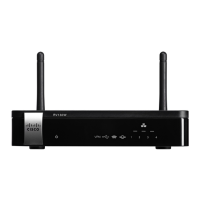
 Loading...
Loading...
Do you have a question about the Cisco RV130W and is the answer not in the manual?
| DSL WAN | - |
|---|---|
| Ethernet WAN | Yes |
| SIM card slot | No |
| Wi-Fi band | Single-band (2.4 GHz) |
| Wi-Fi standards | Wi-Fi 5 (802.11ac), 802.11b, 802.11g, Wi-Fi 4 (802.11n) |
| Top Wi-Fi standard | Wi-Fi 5 (802.11ac) |
| WLAN data transfer rate (max) | 1000 Mbit/s |
| Cabling technology | 10/100/1000Base-T(X) |
| Networking standards | IEEE 802.11b, IEEE 802.11g, IEEE 802.11n, IEEE 802.1D, IEEE 802.1p, IEEE 802.1w, IEEE 802.3, IEEE 802.3u |
| Ethernet LAN data rates | 10, 100, 1000 Mbit/s |
| Ethernet LAN interface type | Gigabit Ethernet |
| USB 2.0 ports quantity | 1 |
| Supported network protocols | DHCP, PPPoE, PPTP, L2TP, DNS, IGMP, RSTP |
| Antennas quantity | 2 |
| Security algorithms | WEP, WPA, WPA2-PSK |
| Product type | Tabletop router |
| Product color | Black |
| LED indicators | LAN, Power, USB, WAN, WLAN |
| Output voltage | 12 V |
| Power source type | DC |
| Storage temperature (T-T) | -20 - 70 °C |
| Operating temperature (T-T) | 0 - 40 °C |
| Operating relative humidity (H-H) | 10 - 85 % |